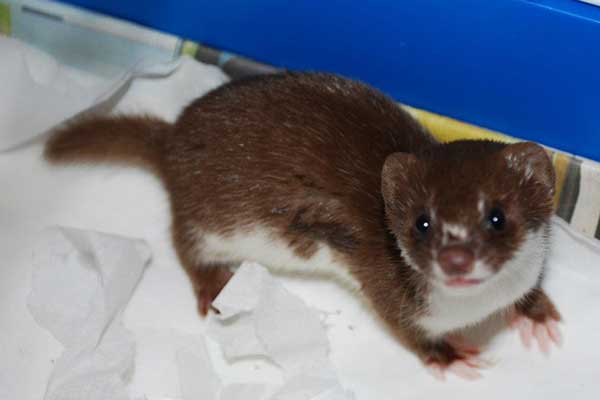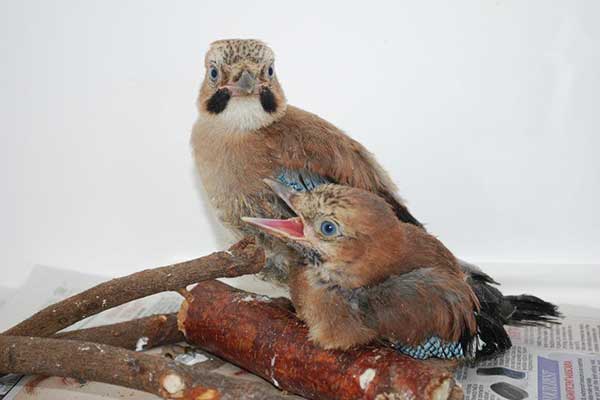As well as the birds, hedgehogs, badgers, and deer we admit, Folly Wildlife Rescue also cares for a wide range of other small animals. These include mice, dormice, squirrels, stoats, weasels, as well as reptiles, amphibians and even fish and invertebrates. If you need help or have a question, call the Helpline 01892 543213 for advice and assistance.
Bats - Dormice - Frogs - Invertebrates - Lizards - Mice, Voles and Shrews
Moles - Rabbits - Rats - Snakes - Squirrels - Stoats and Weasels - Toads
Bats
Bats sometimes enter houses through cracks in brickwork or plaster and can then be found wandering around or hanging on the curtains.
They are frequently targeted by cats and being very delicate creatures, are often badly injured; torn wing membranes and open fractures are not uncommon.
Young bats sometimes become separated from their mothers and are then found out in the daytime or collapsed on the ground.
If you find an injured or distressed bat, or a bat in your house, phone us for advice as we can quickly put you in touch with your nearest bat worker. Do not handle a bat without gloves. In the past few years, a very small number of bats in the UK have tested positive for two strains of European Bat Lyssavirus, a viral disease related to rabies and although the risk to humans is very slight, there was a fatality in 2002.
For more information on how to contain an injured or distressed bat, go to http://www.bats.org.uk/pages/containingabat.html.
Should you happen to be bitten or scratched by a bat, you should immediately contact the Bat Conservation Trust on 0345 1300 228 or your own GP.
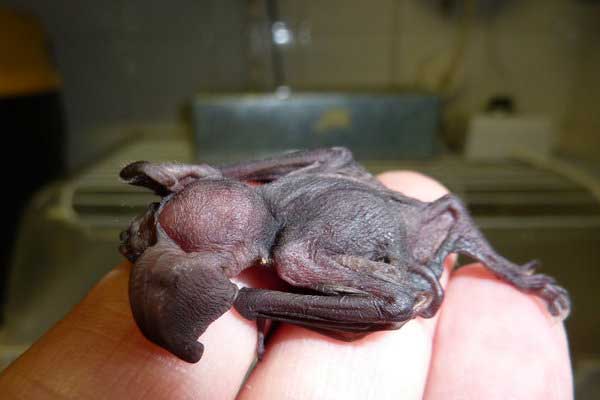
Baby long-eared bat found on the ground.
Dormice
Dormice are admitted after being injured by cats or disturbed by gardeners or builders who have damaged their nests; some are still in hibernation. Injured dormice always need to be admitted for treatment and animals disturbed in hibernation need to be carefully rehabilitated. If an animal is in hibernation, try not to handle it and keep it in a cool place (a shed or garage) until you can get help.
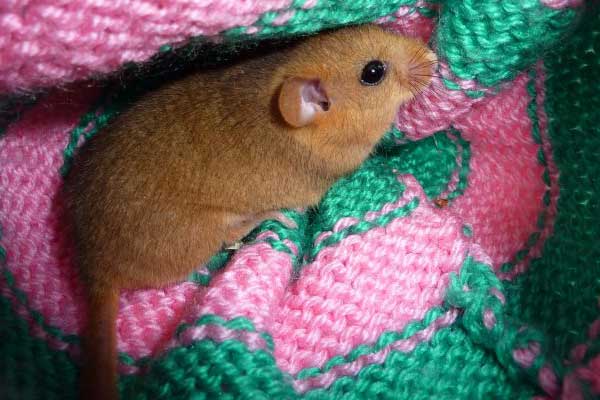
Adult dormouse whose nest fell out of a hedge when workmen were trimming it. Came in at 22.4grams and was released at 24.6grams, which is a great weight!
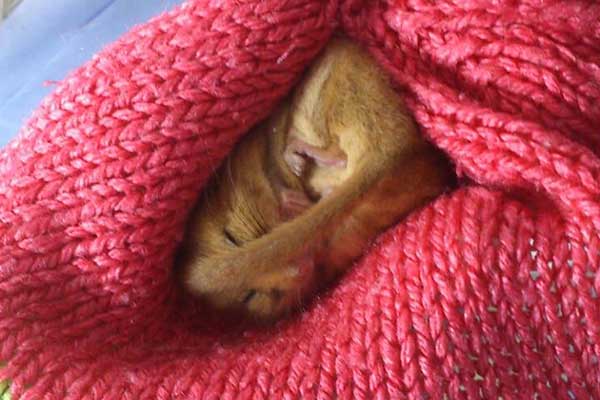
A small female dormouse caught by a cat. She should have ideally been hibernating at circa 40gms but this little lady was a mere 14gms when she came in.
Frogs
Frogs fall victim to cats and are sometimes injured by garden mowers and strimmers. If you are using one of these, especially in long grass or overgrown areas, itís always a good idea to thoroughly check the site first.
Invertebrates
We receive many calls from members of the public who are worried about unusual-looking spiders, caterpillars and other invertebrates they have come across. Very often these turn out to be native species (such as the striking larva of the elephant hawk moth or large specimens of the garden spider) but occasionally, non-native, but naturalised species (such as the tube-web spider and the false widow spider) are involved. Although not dangerous, they can look a little formidable!
We can also put you in contact with local bee keepers who will deal with swarms.

A tarantula type spider found in someones luggage after a trip to Cyprus. About 2 1/2 - 3 inches long. This spider was rehomed with an arachnid expert/enthusiast.
Lizards
Only two types of lizard are found in the region, the common lizard and the slow-worm, which is a legless species. The majority of the casualties we see have been injured by cats, but garden machines, especially strimmers, also take their toll. If youíre using one of these, do check the area to be cleared thoroughly before you commence work.
Both species will, when attacked by a cat, cast their tails. This is a defensive manoeuvre, as the cast tail then wiggles rapidly, the cat is distracted, allowing the lizard to escape; that’s the theory, but it doesn’t always work. If the animal survives the attack, it will eventually re-grow the tail.
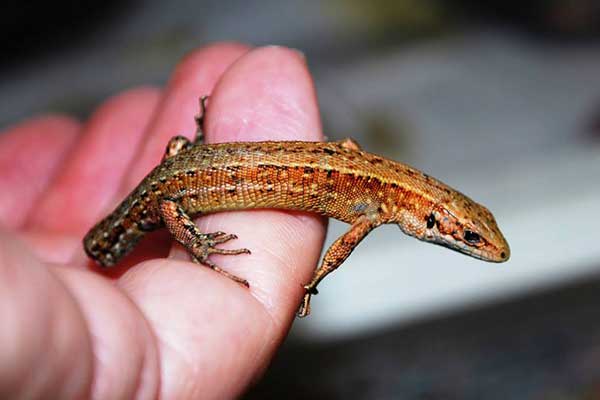
Common Lizard
Mice, Voles and Shrews
We admit many mice, voles and shrews which have either fallen victim to cats or have had their nests disturbed.
Injured animals should always be admitted for treatment. The most common species are wood mice, house mice, long-tailed field vole and the common shrew but we also see the occasional harvest mouse, bank vole and pygmy shrew.
If you disturb a nest when clearing out the garden shed or working in the garden, do not handle the young, but cover them up quickly and retire. The mother may have been seen to shoot off, but if left completely undisturbed for a few hours, she will usually return and move them to a safe place.
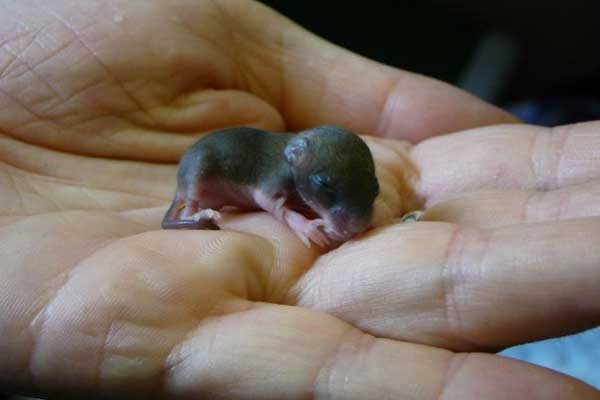
Little field mouse, brought in after its nest was disturbed
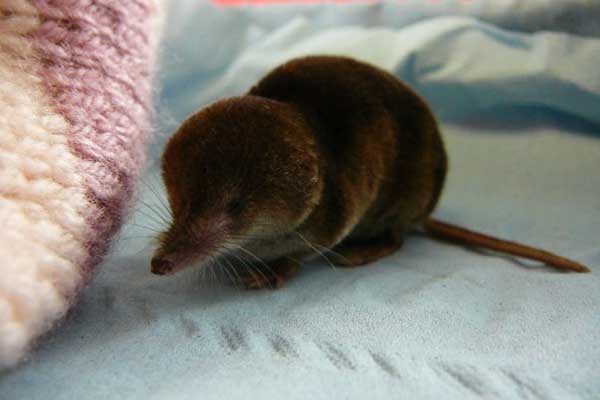
Shrew - found walking slowly across a road
Moles
Moles are very territorial and outside of the breeding season will not tolerate another mole in their home range. At the end of the breeding season the young are driven out and disperse to find their own territories.
This dispersal is above ground and the mortality rate at this time is extremely high. They are sometimes presented to us after having been caught by cats. Handle a mole with care, using stout gloves as they have very sharp teeth!

A young mole that was caught by a cat above ground. Not injured and eating very well. We released it the next day at a new location. Young moles can be found above ground when they disperse from their mother's home territory to find new territory for themselves.
Rabbits
Large numbers of rabbits are killed and injured by cars.
Many young rabbits are injured after being caught by cats or dogs.
Baby rabbits are reared in a grass and belly fur-lined nest in a shallow hole called a ‘stop’ Nests are also sometimes made in sawdust piles or old muck heaps. The mother returns very briefly, once a day to feed her babies, carefully sealing the entrance with soil and vegetation after she leaves. The young appear above ground at around 18 days of age and are fully weaned within the following week. These are the baby bunnies you frequently see hopping around the garden and at this stage there is no further maternal care and they are very much on their own; mortality rates at this time are high.
One of the biggest killers of rabbits is the deliberately introduced disease, myxomatosis which first appeared in the UK in 1953. The disease, which is a virus, is spread by fleas and other biting insects and is often transmitted when infected fleas pass from the mother onto her young when she is feeding them. Rabbits are now becoming increasingly resistant to it, but mortality rates can still be high.
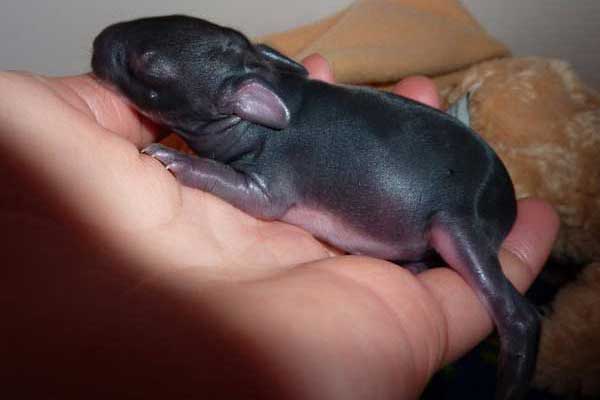
Baby rabbit, named Lucky Jim by the finders. He was brought in by a cat, however, there are no obvious injuries and he's feeding well so fingers crossed he makes it passed the sensitive period
Myxomatosis outbreaks usually occur in the spring and late summer/autumn. There is no cure but animals admitted with it often continue to feed and groom themselves until they eventually succumb.
If you come across a rabbit with the disease (and they can very often be found sitting in or near the road), the symptoms are unmistakable; badly swollen eyes, nasal discharge and very bony appearance.
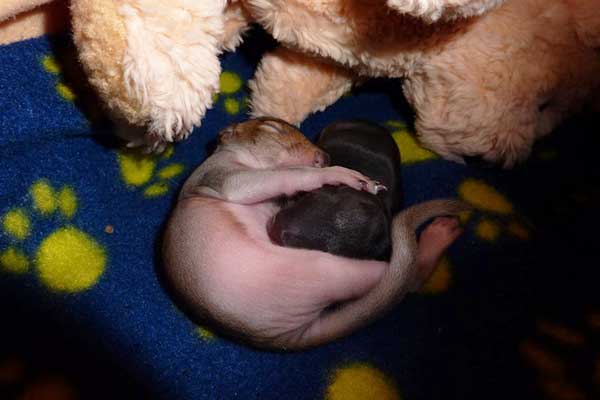
Lucky Jim the rabbit and his new friend, a baby squirrel, snuggle up together in a warm incubator.
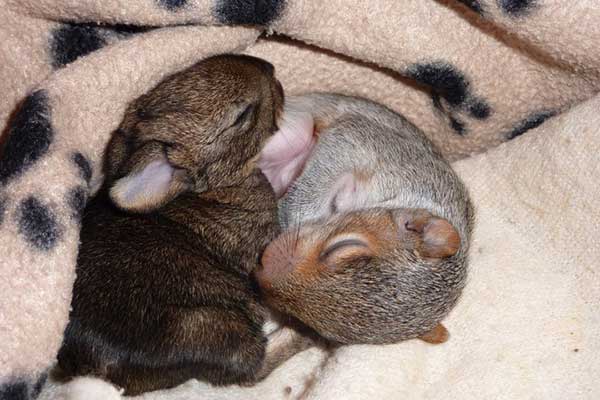
Lucky Jim the rabbit and his squirrel friend. Getting bigger and now with their coats growing nicely.
Rats
Comparatively few rats are admitted and those that are have frequently found to have been poisoned. Symptoms include general sluggishness and instability. Even very sick rats are likely to bite, so it isn’t a good idea to try and pick one up; many also carry Weil’s disease, which can be fatal to humans, so great attention must be paid to personal hygiene.
Nests of baby rats are sometimes admitted here after having been disturbed, but they are difficult and problematic to rear, so whenever possible, they should be left alone as the mother will usually return and move them to a safer place.
Snakes
Two of the UK’s three species of snake are found in the region, the grass snake and the adder.
Nine out of every 10 calls we receive involve the non-venomous and completely harmless grass snake, a common visitor to garden ponds where it hunts frogs and small fish.
Very occasionally the snake will be an adder and most of those we admit have become entangled in garden netting. Adders are not normally aggressive (unless handled or threatened) but in these situations the animal will be frightened and is likely to bite, so the disentangling should only be carried out by an expert.
Only 10 or so people in the UK have died after being bitten by adders in the last 100 years, so they are not a major threat to life and limb.
Adders are protected by law and must not be harmed.

This snake was found caught in some discarded netting.
Never handle or attempt to handle any snake if you are unsure of its identity. The majority of people bitten by adders have been injured while trying to scoop them into buckets or pick them up by their tails.
Far more common than adders are escaped or abandoned pet snakes. In the past these have included corn, rat and king snakes and even an 8 foot boa constrictor.
Squirrels
The grey squirrel is a non-native species introduced to the UK from North America in the 19th and 20th centuries.
Prior to 2018, Folly Wildlife Rescue were able, under a licence issued by Natural England, to admit, treat and return to the wild a small number of injured or orphaned grey squirrels, but with the introduction of the Alien Invasive Species Order 2019, this is no longer possible, as all licences to return the species to the wild have now been withdrawn.
Very regrettably, this is a situation beyond our control, and we have to abide by the law.

An unusual albino squirrel.
Squirrels can cause considerable damage as they will chew items stored in the loft as well as electrical cables.
Baby squirrels, often orphaned after their mothers have been killed in road traffic accidents or injured when their nests have been attacked by crows, will approach people and even follow them around. In these instances it is best to pick them up in a tea towel or with gloves and confine them in a cat basket or stout cardboard box until you can get help.
Stoats and Weasels
The stoat and its smaller relative, the weasel, are members of the same family as badgers, ferrets and otters.
Cats will sometimes attack weasels and the young of both species are sometimes brought to us after having been found wiggling around in the grass. It’s very likely that the mother has been moving them and then been disturbed in the process.
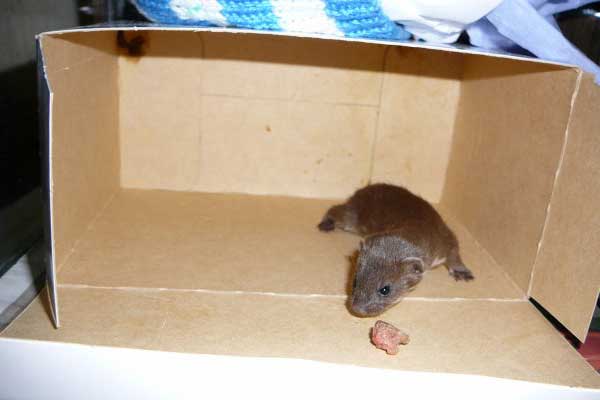
Little stoat found on a busy road. No injuries and eating for itself .
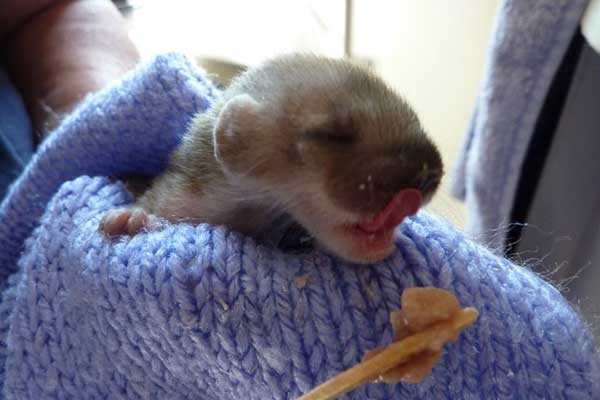
Baby stoat that was found alone and cold on the ground in a wood. Eating meat off a lollipop stick!
Toads
During the spring migration to their breeding grounds, many toads are killed and injured by cars.
Toads also suffer crushing injuries when log piles are dismantled.
Like frogs, they are often the victims of garden machines such as mowers and strimmers. If you are using one of these machines, follow the guidelines above for Frogs.
How do you tell the difference between a frog and a toad? Toads are generally stouter, have a warty appearance and walk rather than hop. Frogs are also more ‘pointy’ in appearance, have smooth skins and hop rather than walk.

A toad that was brought to us on the after it was found in an oil pit at a railway station. We released it after finding it unharmed from any oil that may have got on it.
You can make a secure online donation via our CAF page.
Click on the button below and a new page will open with a variety of options with which to pay online.
Your kind and generous donation will directly help injured wildlife.

It is easy to set up a regular standing order by clicking the CAF image below. You will be taken to The Southern Wildlife Care and Advisory Trust's page on the CAF website where it will take just a few easy steps to set up a standing order by direct debit.

easyfundraising.org.uk is a great way to raise money for Folly Wildlife Rescue just by shopping online. You donít pay anything extra.
All you need to do is use click on the banner below to use our easyfundraising portal. Every time make a purchase from your favourite online retailers using the link below Folly Wildlife Rescue will receive a small payment, with no extra cost to you.

With the endless stream of wildlife casualties brought in to Folly Wildlife Rescue we are continually looking for stocks of essential items to aid recovery. With the introduction of our new nursery we will be able to cater for even more little babies, and with that comes more expense and that is where you, our supporters, may be able to help.
Our Amazon Wish List is updated frequently with all the essential items we needr. Your support is absolutely invaluable to us and every item purchased is a vital saving for our charity.

An adoption pack makes a great gift for a birthday or Christmas (or you can always treat yourself!) and is a very practical way to help hedgehogs in distress.
As well as illnesses and injuries the species is now seriously threatened by loss of habitat and housing developments, increased road traffic and unsympathetic farming practices



















